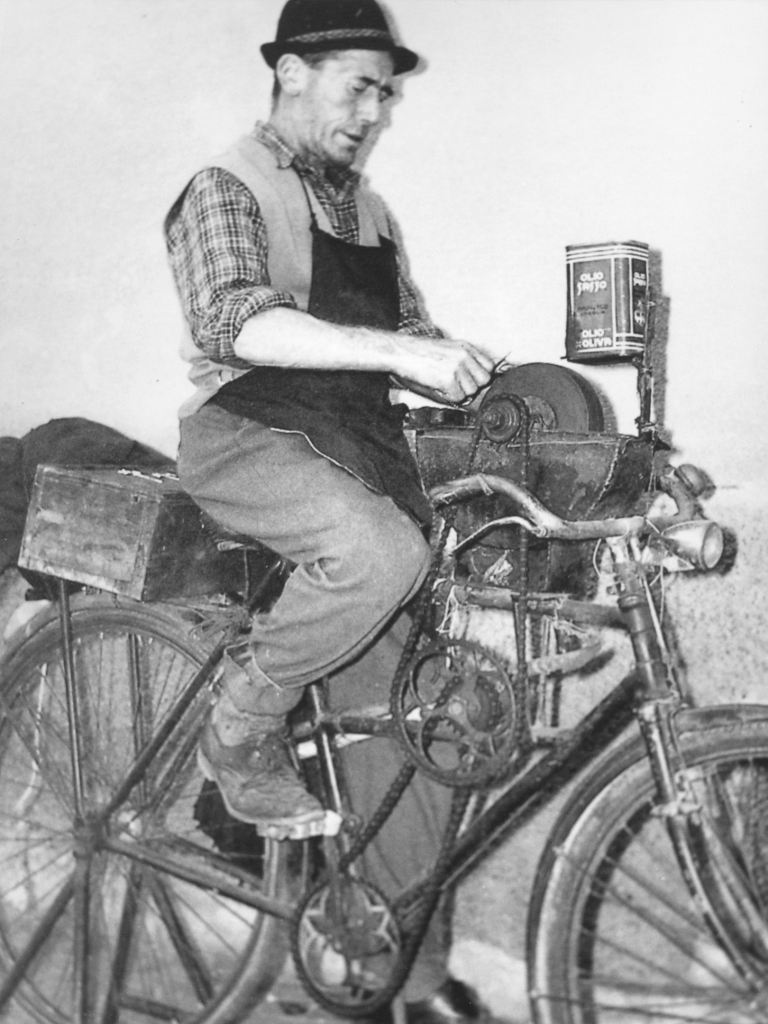 The "muléta", Defendente Pegorari.
The "muléta", Defendente Pegorari.
The knifegrinder's work tool was the
möla, a large wooden wheel encircled by a band of iron, with two small wheels (an abrasive stone and the grinder to polish) worked by the drive belt of the larger wheel, moved in turn by the pedal on the side of the cart, which had an ingenious system of a handle and pedal to transform vertical movement to a rotating movement.
Behind the wheel was a tiny box with all the work tools, a change of underwear and sometimes a store of food.
Above the wheel was a little bucket with a small tap hanging from a stick fastened to the wheel.
This slowly allowed the water to drip over the tools to be ground, to wash away the dust from all the rubbing and to prevent the tools from overheating.
A rag hung at the side to clean the ground tools, and above was a small anvil for minor repairs.
Towards the fifties, the wheel was gradually replaced by the bicycle: the abrasive wheel and the bucket were installed on the handle and a series of chains connected to the pedals moved them.
The knifegrinder sat on the saddle, pedalled and ground, balancing on the iron kick-stand.
The bicycle chain was unhooked and placed on the multiple head to turn the wheel.
 The muléta, Renato Bracelli.
The muléta, Renato Bracelli.
A few years later, the bicycle was replaced by the motorbike and the Vespa.
The wheel was fastened at the back and connected to the engine.
It was a big jump in quality for the knife grinder, who saved himself not only the effort of moving around on foot and of turning the wheel, but also a considerable amount of time.
From the motorbike to the three-wheeled van, the Ape, was but a short step.
A spark ignition engine was placed in the rear pickup, protected by a canvas, whereas the tiny cab protected the knifegrinder from the bad weather and the cold.
The knifegrinder soon became a travelling tradesman as he was not only a grinder but also sold new tools, such as scissors and knives.
His standard of living soon changed: alone or with other knifegrinders he hired a room in old houses, where he could prepare an evening meal and sleep more comfortably.
He could also return more often to his village.
Towards the 70s, the figure of the
muléta disappeared almost completely.
Many inhabitants from Caspoggio found work in other sectors, such as construction, tourism and commerce.
A few travelling muléta set up in the village and opened a workshop for this trade.
By the 90s, however, the work of the muléta had completely disappeared.
Bibliography
-
Marino Amonini,
I muléta de Caspöcc’, in
“Le Montagne Divertenti”,
No. 16 (2011)
-
Antonio Boscacci,
Lo ricordo così, in
“Le Montagne Divertenti”,
No. 16 (2011)
-
Franco Dioli,
Caspoggio nel secondo millennio,
Sondrio 2004
-
Sandrino Miotti – Rodolfo Pegorari,
Inventario dei toponimi valtellinesi e valchiavennaschi. 18 Territorio comunale di Caspoggio, Società Storica Valtellinese,
Sondrio 1986